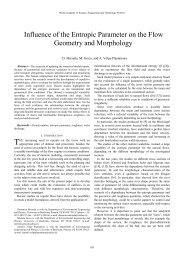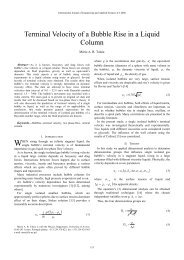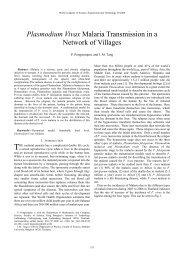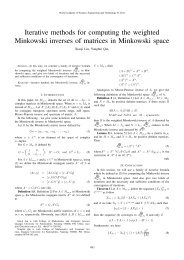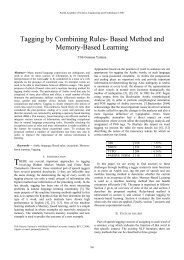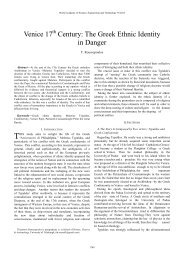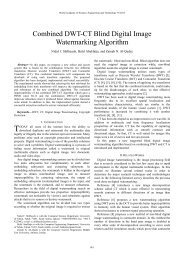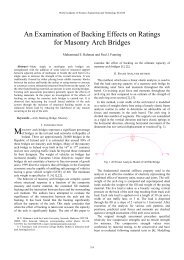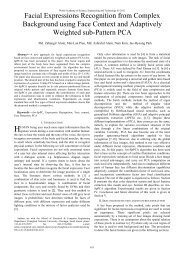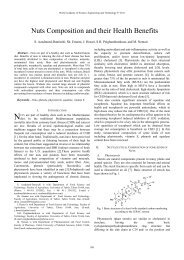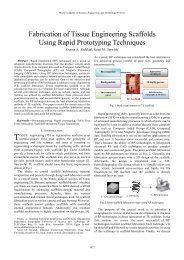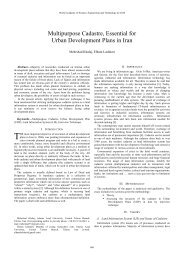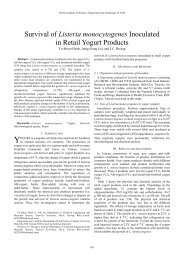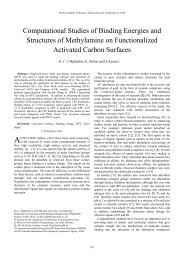Designing and Manufacturing High Voltage Pulse Generator with ...
Designing and Manufacturing High Voltage Pulse Generator with ...
Designing and Manufacturing High Voltage Pulse Generator with ...
You also want an ePaper? Increase the reach of your titles
YUMPU automatically turns print PDFs into web optimized ePapers that Google loves.
Abstract—Using strength <strong>Pulse</strong> Electrical Field (PEF) in food<br />
industries is a non-thermal process that can deactivate<br />
microorganisms <strong>and</strong> increase penetration in plant <strong>and</strong> animals tissues<br />
<strong>with</strong>out serious impact on food taste <strong>and</strong> quality. In this paper<br />
designing <strong>and</strong> fabricating of a PEF generator has been presented.<br />
<strong>Pulse</strong> generation methods have been surveyed <strong>and</strong> the best of them<br />
selected. The equipment by controller set can generate square pulse<br />
<strong>with</strong> adjustable parameters such as amplitude 1-5kV, frequency 0.1-<br />
10Hz, pulse width 10-100µs, <strong>and</strong> duty cycle 0-100%. Setting the<br />
number of pulses, <strong>and</strong> presenting the output voltage <strong>and</strong> current<br />
waveforms on the oscilloscope screen are another advantages of this<br />
equipment. Finally, some food samples were tested that yielded the<br />
satisfactory results. PEF applying had considerable effects on potato,<br />
banana <strong>and</strong> purple cabbage. It caused increase Brix factor from 0.05<br />
to 0.15 in potato solution. It is also so effective in extraction color<br />
material from purple cabbage. In the last experiment effects of PEF<br />
voltages on color extraction of saffron scum were surveyed (about<br />
6% increasing yield).<br />
P<br />
Keywords—PEF, Capacitor, Switch, IGBT<br />
I. INTRODUCTION<br />
ULSE-shaped voltage is required in many applications<br />
such as PEF food preservation, radar, laser, <strong>and</strong><br />
accelerators. <strong>Pulse</strong>d Electrical Field (PEF) technology is based<br />
on the phenomena that biological membranes are punctured<br />
when an external electrical impulse is applied. This can be<br />
helpful, for example, in producing fruit juices, by improving<br />
the yields of extractable ingredients so that enzyme treatment<br />
can be avoided or reduced <strong>and</strong> the quality of the juice can be<br />
improved[1].<br />
In the PEF process, the effects of the pulse shape on the<br />
level of inactivation has been investigated by researchers ([2]-<br />
[3]). The investigations indicate that the preferred pulse shape<br />
is more or less a square, where a certain minimum threshold<br />
voltage should be established during a certain minimum time<br />
([4]-[5]). In particular in high power applications, such as PEF<br />
on industrial scale, it is difficult to generate a square shape<br />
because of parasitical structural impedances <strong>and</strong> the level of<br />
impedance matching <strong>and</strong> the availability of the required<br />
H. Mirzaee is <strong>with</strong> the Department of Electrical <strong>and</strong> Electronic<br />
Engineering Khorasan Research Institute for Food Science & Technology,<br />
Mashhad, Iran (phone: +98-511-5003333; fax: +98-511-5003332; e-mail:<br />
mirzaee@ krifst.ir).<br />
A. Pourzaki is <strong>with</strong> the Department of Electrical <strong>and</strong> Electronic<br />
Engineering Khorasan Research Institute for Food Science & Technology,<br />
Mashhad, Iran (phone: +98-511-5003333; fax: +98-511-5003332; e-mail:<br />
pourzaki@ krifst.ir)<br />
World Academy of Science, Engineering <strong>and</strong> Technology 60 2011<br />
<strong>Designing</strong> <strong>and</strong> <strong>Manufacturing</strong> <strong>High</strong> <strong>Voltage</strong><br />
<strong>Pulse</strong> <strong>Generator</strong> <strong>with</strong> Adjustable <strong>Pulse</strong> <strong>and</strong><br />
Monitoring Current <strong>and</strong> <strong>Voltage</strong>: Food<br />
Processing Application<br />
H. Mirzaee, A. Pourzaki<br />
659<br />
switch devices [6].<br />
Electrical pulses can be generated <strong>with</strong> different wave<br />
shapes including exponentially decaying, square waves <strong>and</strong><br />
oscillating pulses. Moreover, they can be monopolar or<br />
bipolar.<br />
Monopolar exponential decaying <strong>and</strong> monopolar/bipolar<br />
square wave pulses are the most common in the application of<br />
PEF in food technology. Switch is one of the most important<br />
parts in pulse generators[7].<br />
Solid state switches such as SCR (Silicone Controlled<br />
Rectifier), GTO (Gate Turn-off) or IGBT (insulated Gate<br />
Bipolar Transistor) switches require less complex driving<br />
circuits <strong>and</strong> are easy to h<strong>and</strong>le <strong>and</strong> control by external<br />
triggering <strong>and</strong> optimum variability of pulse parameters. In a<br />
capacitive storage system, when the high voltage switch is<br />
closed by a trigger signal or after its breakdown voltage has<br />
been achieved, the energy stored is discharged to ground<br />
across the discharge circuit <strong>with</strong> a protective resistor <strong>and</strong> the<br />
treatment chamber <strong>with</strong> the food material.<br />
Generation of an exponential decay pulse requires a switch<br />
<strong>with</strong> turn on capability only, as the total energy stored in the<br />
capacitor bank will be discharged. Square wave pulses can be<br />
realized either by an incomplete discharge of a capacitor <strong>with</strong><br />
high capacity by a switch <strong>with</strong> on/off capability or a more<br />
complex pulse forming network, providing a relatively<br />
constant voltage during the pulse width. As switches <strong>with</strong> turn<br />
off capability are hardly available for high power application<br />
systems ([8]), serial or parallel connections of switches ([9])<br />
or lumped or distributed pulse forming networks <strong>with</strong> several<br />
sections of capacitors <strong>and</strong> inductive elements have to be used.<br />
Square wave pulses maintain a high voltage level for the total<br />
impulse width, whereas exponential pulses have a long tail<br />
<strong>with</strong> low electric field. Studies comparing the efficacy of<br />
different pulse waveforms for PEF inactivation have been<br />
conducted ([10]), which concluded that both are effective for<br />
microbial inactivation, but square wave pulses would save<br />
energy <strong>and</strong> require less cooling effort.<br />
A square pulse can, amongst others, be generated <strong>with</strong> a<br />
hard-switched circuit where a large capacitor is connected to<br />
the load during the specified time. The capacitor is large<br />
enough to neglect the voltage drop during pulsing. In such a<br />
hard-switched circuit the switch should have turn-off<br />
capability, which implies that this type of circuit is limited to<br />
low <strong>and</strong> moderate power levels, because switches <strong>with</strong> turnoff<br />
capability, such as IGBT’s (Insulated Gate Bipolar<br />
Transistor) or MOSFET’s, are not available for high power[8].
However, by series <strong>and</strong> parallel connection of these switches<br />
the power range is continuously increasing in the last decade<br />
([9], [11],[12]).<br />
Treatment chamber: The other major component of a PEF<br />
unit is the treatment chamber, used to transfer electrical<br />
voltage pulses to food. It basically consists two electrodes.<br />
The proper design sign of the treatment chamber is important in<br />
order to assure the effective cellular permeabilization during<br />
the process. Many aspects have to be considered such as<br />
geometry, size <strong>and</strong> construction materials. In order to be able<br />
to carry out the treatment, the material used as insulator of the<br />
treatment chamber should have dielectric strength exceeding<br />
the applied electric field intensity. Stainless steel represents<br />
the most suitable choice for the electrodes <strong>and</strong> has been<br />
extensively used ([1], [13], [14] ,[15] ,[16] [16]). Anyway, the use<br />
of other electrochemical inert material including carbon, gold,<br />
platinum m <strong>and</strong> metal oxides has been reported for the electrodes<br />
or electrode surfaces ([17]).<br />
Insulator materials used are: Plexiglas ([15]); ( polysulfone<br />
([1]), PVC ([19]). ). Several geometries of the electrodes have<br />
been proposed. Parallel plate electrodes <strong>with</strong> a small gap<br />
between them provide a uniform electric field <strong>and</strong> represent<br />
the most practical choice of batch chambers ([14]). ( Diskshaped<br />
<strong>and</strong> round edged electrodes can minimize the electric<br />
field enhancement reducing also the possibility of dielect dielectric<br />
breakdown ([1], [18]).<br />
Semiconductor solid-state state switches are considered the most<br />
convenient option for future applications of the PEF<br />
technology. Solid-state state switches have a very large operation<br />
life span when compared to other type of switches, have better<br />
performance, are easier ier to h<strong>and</strong>le, do not require mechanical<br />
components (electrodes or gases), allow higher pulsing<br />
frequencies <strong>and</strong> have low switching <strong>and</strong> conducting losses;<br />
their price also tends to drop, which is common <strong>with</strong><br />
semiconductor operated equipment.<br />
In high voltages, es, thyristors can be used series; but for<br />
simultaneously turn on each thyristor need high <strong>and</strong> quick<br />
current pulse gate. The pulse transformers that are able to do<br />
isolation up to several kilovolts, their inductance leakage is<br />
low <strong>and</strong> cause gate pulse of quick uick high current <strong>and</strong> so they are<br />
great <strong>and</strong> expensive.<br />
Isolated gate bipolar transistors (IGBTs) can be used to<br />
construct high voltage <strong>and</strong> power switch. Generally IGBTs<br />
<strong>with</strong> respect to thyristors, have shorter turning on time, faster<br />
rise time, <strong>and</strong> simpler r turning off. But the on dissipation of<br />
IGBTs is more than thyristors.<br />
Turning on <strong>and</strong> off time of MOSFETs <strong>and</strong> IGBTs have<br />
about one hundred nanosecond (ns) <strong>and</strong> about hundreds of<br />
nanosecond to a microsecond (µs); respectively. Therefore<br />
switching frequency of MOSFETs is higher than IGBTs.<br />
<strong>Voltage</strong> drop on MOSFETs drain <strong>and</strong> source is changed from<br />
3 to 10V but on IGBTs is usually below 2V. So the dissipation<br />
of the lightness situation of MOSFET circuits is more than<br />
IGBT. Table 1 shows briefly characteristics of three type of<br />
described semiconductor switch.<br />
World Academy of Science, Engineering <strong>and</strong> Technology 60 2011<br />
660<br />
TABLE I<br />
THE CHARACTERISTICS OF MOSFET, THYRISTOR AND IGBT SWITCH<br />
Characteristics/switch Mosfet IGBT Thyristor<br />
Turning off capability Has Has<br />
Doesn’t<br />
Have<br />
Speed<br />
Faster Medium Slower<br />
Cost More Expensive Medium Cheaper<br />
Static dissipation <strong>High</strong>er Medium Lower<br />
II. SYSTEM YSTEM DESIGNING<br />
In the system design process, general specification of<br />
electrical equipment, electronic hardware (digital <strong>and</strong> analog)<br />
<strong>and</strong> software, <strong>and</strong> relation of these components <strong>with</strong> each<br />
other will be determined.<br />
Fig. 1 The general form of the PEF equipment<br />
A. Electrical section specifications<br />
All tables <strong>and</strong> figures you insert in your document are only<br />
to help you gauge the size of your paper, for the convenience<br />
of the referees, <strong>and</strong> to make it easy for you to distribute<br />
preprints.<br />
General system of high voltage pulse generation is observed<br />
in figure 1. The voltage increases by a transformer from line<br />
220V to high voltage 1000 to 5000V. It is rectified <strong>and</strong> stored<br />
in DC form in a capacitor r by the diode. Capacitor voltage is<br />
transformed to narrow pulses by triggering signal (Vpulse)<br />
<strong>and</strong> using the switch. Now, each one of these components will<br />
be characterized.<br />
Transformer: Necessary output voltage is 1- 1 5 kV, therefore<br />
we need a transformer r so that it can change line power 220V<br />
to output selective voltage between 11-5<br />
kV. Switching power<br />
supply has been used so that changing its frequency tends to<br />
various voltages in the output.<br />
Capacitor: The minimum desired load resistance is 150Ω. 150<br />
Necessary ary maximum pulse width is 100µs; i.e. in the worst<br />
situation, in interval of 100µs, the current of 33A must be<br />
loaded. Assumed capacitor will be discharged after each<br />
pulsing. So we can calculate energy of each pulse as<br />
following: W=Pt=VIt≅5000*33*100*10<br />
5000*33*100*10-6=16.5w<br />
This energy is provided by capacitor that is: W=0.5 CV2<br />
Then: C=2W/V2=2*16.5/50002=1.32µF<br />
For certainty, a 2µF capacitor bank is used. Capacitor bank<br />
is constructed using series <strong>and</strong> parallel capacitors <strong>with</strong><br />
following specification:<br />
• Individual capacity: 1µf<br />
• Maximum tolerable voltage: 1300V<br />
• Maximum instantaneous current: 1000A<br />
• Maximum voltage of total capacitor: 5200 V
• Capacitors number: 32<br />
So each four capacitors are series together <strong>and</strong> package. All<br />
eight packages are fastened parallel. Finally the capacitor bank<br />
resin insulated <strong>and</strong> constructed <strong>with</strong> dimension 13*13*15cm.<br />
Diode: The diode rectifies ac output of transformer in the<br />
form of semi-wave <strong>and</strong> charges the capacitor. It should<br />
tolerate the current that charges the capacitor. Tolerable<br />
voltage of the diode in the cutoff situation is as following:<br />
VD(max)≅5 kV, IC(ave)=Pave(in)/<br />
VD(max)=165/5000=33mA<br />
Practically seven number of one ampere <strong>and</strong> one kilovolt<br />
diodes by name BYT52M are series <strong>and</strong> insulated <strong>with</strong> resin.<br />
Switch: The repetition rate is between 1 <strong>and</strong> 10 Hz <strong>and</strong> has<br />
to be programmable. Therefore a controllable switch should be<br />
existed in path of the load so that <strong>with</strong> control of the switch by<br />
a controllable <strong>and</strong> programmable circuit, the pulse frequency<br />
was controlled between 0.1 <strong>and</strong> 10 Hz. Other parameters were:<br />
V=5kV , I=33A , ton
C. Experiment chamber<br />
The chamber has been constructed in dimensions of 10*10<br />
cm <strong>with</strong> depth of 1-5cm (figure 4-a). a). Metallic plates are made<br />
<strong>with</strong> stainless-steel-316. 316. The insulator all around is from Plexy<br />
Glass. Figure 4-b b shows the practical constructed chamber.<br />
a<br />
b<br />
Fig. 4 a)Dimention of fabriquated plates b)final chamber<br />
A. Software<br />
III. CONTROLLER DEVICE EVICE DESIGN<br />
In the control unit panel there are several keys for entering<br />
data <strong>and</strong> comm<strong>and</strong>s. MENU key is used to set the machine<br />
parameters which appear a new environment. Parameters are<br />
selected by UP <strong>and</strong> Down key, <strong>and</strong> d then the controller will be<br />
ready to receive new data. Pressing ENTER key tend to<br />
confirm inserted number. Entered setting parameters are saved<br />
in the E2PROM memory of the controller. MENU<br />
environment is as following:<br />
1. <strong>Voltage</strong>: 0-5 kV >>-.->-.->--->---->---
Reflection <strong>and</strong> Brix factor of potato in water (before <strong>and</strong><br />
after PEF) is presented in table 2. Three sample was<br />
examinated in 5kV/cm field intensity, 100µs pulse duration<br />
<strong>and</strong> 20 pulse number.<br />
TABLE II<br />
REFLECTION AND BRIX FACTOR OF POTATO IN WATER (BEFORE AND AFTER<br />
PEF)<br />
Before PEF After PEF<br />
Brix factor 0.05 0.15<br />
Reflection factor 1.33307 1.33317<br />
In another experiment that differs from others, washed<br />
scums were tested. After 8min mixing saffron washed out <strong>and</strong><br />
treated. Figure 8 shows the graph of the saffron effective<br />
materials for intact tissue <strong>and</strong> after PEF applying at pulse<br />
width of 100µs, electric field strength of 5kV, <strong>and</strong> pulse<br />
number of 40. AS seen, PEF caused to about 6% increasing in<br />
color extraction of saffron.<br />
Absorbance<br />
1.5<br />
1<br />
0.5<br />
0<br />
PEF <strong>Voltage</strong> Effect (Saffron scums)<br />
A1 A2 A3<br />
Fig. 8 The graph of the saffron effective materials for intact tissue<br />
before <strong>and</strong> after PEF applying (at 100µs 5kV, n=40). A1: color; A2:<br />
taste; A3: aroma<br />
V. CONCLUSION<br />
A pulse-shaped voltage is required in many applications<br />
such as PEF food preservation, radar, laser <strong>and</strong> accelerators.<br />
In this paper designing <strong>and</strong> fabricating of a PEF generator<br />
has been presented. In this work pulse generation method was<br />
based on switching transformer <strong>and</strong> serial IGBT switches.<br />
Semiconductor solid-state switches are considered the most<br />
convenient option for future applications of the PEF<br />
technology. Solid-state switches have a very large operation<br />
life span when compared to other type of switches, they have<br />
better performance, are easier to h<strong>and</strong>le, do not require<br />
mechanical components (electrodes or gases), allow higher<br />
pulsing frequencies <strong>and</strong> have low switching <strong>and</strong> conducting<br />
losses<br />
The equipment <strong>with</strong> controller set can generate square pulse<br />
<strong>with</strong> adjustable parameters. Food container dimensions were<br />
10×10cm <strong>with</strong> distance of 1-5cm. Their cover was made from<br />
fiberglass insulation <strong>and</strong> metal plates from stainless-steel-316.<br />
In the system design process, general specification of<br />
electrical equipment, electronic hardware (digital <strong>and</strong> analog)<br />
<strong>and</strong> software, <strong>and</strong> relation of these components was<br />
determined.<br />
World Academy of Science, Engineering <strong>and</strong> Technology 60 2011<br />
Untreated<br />
PEF treated<br />
663<br />
Necessary output voltage is 1- 5 kV; therefore we need a<br />
transformer so that it can change line power 220V to output<br />
selective voltage between 1-5 kV. Switching power supply has<br />
been used so that changing its frequency tends to various<br />
voltages in the output. This voltage has adjustment capability<br />
from 1 to 5 kilo volt. The minimum desired load resistance is<br />
150Ω. Necessary maximum pulse width is 100µs; i.e. in the<br />
worst situation, in interval of 100µs, the current of 33A must<br />
be loaded. The diode rectifies ac output of transformer in the<br />
form of semi-wave <strong>and</strong> charges the capacitor. It should<br />
tolerate the current that charges the capacitor. Practically<br />
seven number of one ampere <strong>and</strong> one kilovolt diodes by name<br />
BYT52M are series <strong>and</strong> insulated <strong>with</strong> resin. The repetition<br />
rate is between 1 <strong>and</strong> 10 Hz <strong>and</strong> has to be programmable.<br />
Therefore a controllable switch should be existed in path of<br />
the load so that <strong>with</strong> control of the switch by a controllable<br />
<strong>and</strong> programmable circuit, the pulse frequency was controlled<br />
between 0.1 <strong>and</strong> 10 Hz. The switch has been formed from<br />
seven series stages. Each stage is a switch module <strong>with</strong> a<br />
1200V IGBT. Each module separately is fed <strong>with</strong> isolated<br />
driver.<br />
Controller hardware unit of the PEF machine has been<br />
designed <strong>and</strong> constructed using an AVR microcontroller type<br />
ATMEGA32. Necessary information is received by keyboard<br />
4*4. One 4*20 characteristic indicator screen shows system<br />
work situation <strong>and</strong> necessary information. Three output<br />
signals control the PEF machine which is produced by this<br />
controller: two DC signal (0-5V) <strong>and</strong> a trigger pulse. These<br />
DC signals are used to define voltage <strong>and</strong> pulse width of the<br />
machine. The DC signals are generated using PWM technique<br />
<strong>with</strong> micro so that an op-amp circuit converts pulses duty<br />
cycle to DC equivalent. Trigger pulse determines the<br />
frequency <strong>and</strong> instant of pulse generating.<br />
PEF applying has considerable effects on potato, banana<br />
<strong>and</strong> purple cabbage. It caused increase Brix factor from 0.05<br />
to 0.15 in potato solution. It is also so effective in extraction<br />
color material from purple cabbage. In the last experiment<br />
effects of PEF voltages on extraction of saffron scum were<br />
surveyed that yielded about 6% increasing.<br />
REFERENCE<br />
[1] M. Guderjan, P. Elez-Martinez, D. Knorr, “Application of <strong>Pulse</strong>d<br />
Electric Fields at Oil Yields <strong>and</strong> Content of Functional Food Ingredients<br />
at the Production o Rapeseed Oil”, Innovative food science <strong>and</strong><br />
emerging technologies, No. 8, Apr. 2007, pp. 55-62.<br />
[2] Q. Zhang , G.V. Barbosa, B.G. & Swanson, “Engineering aspects of<br />
pulsed electric field pasteurisation”, Journal of Food Engineering, No.<br />
25, 1995, pp.261 –281.<br />
[3] V. Heinz, A. Angerbach, D. Knorr, “Membrane permeabilization in<br />
biological materials in response to pulsed electric fields— A highly<br />
efficient process for biotechnology”, International Conference on <strong>Pulse</strong>d<br />
Power Applications, Gelsenkirchen, March 2001, B.03.1–B.03.7.<br />
[4] Q. Qiu, S. Sharma, M. Jia, & Q.H. Zhang, “An integrated PEF Pilot<br />
plant for continuous non-thermal pasteurisation of fresh orange juice”<br />
Transactions on American Society of Agricultural Engineers, 41(4),<br />
1998, pp.1069 –1074.<br />
[5] T. Grahl, & H. Markl, “Killing micro-organisms by pulsed electric<br />
fields” Applied Microbiology Biotechnology, 45, 1996, pp. 148 –157.<br />
[6] S.W.H. De Haan, B. Roodenburg, J. Morren, H. Prins, “Technology for<br />
preservation of food <strong>with</strong> <strong>Pulse</strong>d Electric fields (PEF)”, Proceedings of
the Africon 2002 Conference on Electrical Engineering, George (SA),<br />
October 2002.<br />
[7] A. Pourzaki, H. Mirzaee, “<strong>Pulse</strong>d Electric Field <strong>Generator</strong>s in food<br />
processing”, 18th National Congress on Food Technology, 15-16 Oct.<br />
2008, Mashhad-Iran.<br />
[8] N. Mohan, T. N. Undel<strong>and</strong>, <strong>and</strong> W. P. Robbins, “Power Electronics;<br />
Converters <strong>and</strong> Design” New York, 1995, Wiley.<br />
[9] M. P. J. Gaudreau, T. Hawkey, J. Petry, <strong>and</strong> M. A. Kempkes, “A solid<br />
state pulsed power system for food processing” 24th <strong>Pulse</strong>s Power<br />
Plasma Science Conference, 2001, Las Vegas, USA.<br />
[10] Kotnik, T., Pucihar, G., Rebersek, M., Miklavcic, D. <strong>and</strong> Mir, L. M.<br />
“Role of pulse shape in cell membrane electropermeabilization”<br />
Biochimica Biophysica Acta, 1614, 2003, 193-200.<br />
[11] V. Chitta, S. Hong, & D.A. Torrey, “Series connection of IGBT’s <strong>with</strong><br />
active voltage balancing” IEEE Transactions on Industry Applications,<br />
35, 1999, 917 –923.<br />
[12] A. Pourzaki, H. Mirzaee, “New <strong>High</strong> <strong>Voltage</strong> <strong>Pulse</strong> <strong>Generator</strong>s”, Recent<br />
Patents on Electric Engineering, Bentham Science Publishers Ltd, Vol.<br />
2, No. 1, Jan 2009, 65-76.<br />
[13] A. Angersbach, V. Heinz, <strong>and</strong> D. Knorr, “Effect of pulsed electric fields<br />
on cell membranes in real food systems” Innovative Food Science <strong>and</strong><br />
Emerging Technologies, 1, 2000, 135-149.<br />
[14] M. Fincan, F. De Vito, <strong>and</strong> P. Dejmek, “<strong>Pulse</strong>d electric field treatment<br />
for solid-liquid extraction of red beetroot pigment” Journal of Food<br />
Engineering 64, 2004, 381-388.<br />
[15] M.N. Eshtiaghi, <strong>and</strong> D. Knorr, “<strong>High</strong> electric field pulse pretreatment:<br />
potential for sugar beet” processing Journal of Food Engineering 53 (2),<br />
2002, 265-272.<br />
[16] N. Menses, H. Jaeger, J. Moritz, D. Knorr, “Impact of Insulator Shape,<br />
Flow Rate <strong>and</strong> Electrical Parameters on Inactivation of E.coli Using a<br />
Continuous Co-linear System”, Innovative food science <strong>and</strong> emerging<br />
technologies, No. 12, Jun. 2011, pp. 6-12.<br />
[17] A. H. Bushnell, J. E. Dunn, R.W. Clark, <strong>and</strong> J. S. Pearlman, “<strong>High</strong><br />
pulsed voltage systems for extending the shelf life of pumpable food<br />
production”, 1993, U.S. Patent 5,235,905.<br />
[18] K. Huang, J. Wang ,“Designs of <strong>Pulse</strong>d Electric Fields Treatment<br />
Chambers for Liquid Food Pasteurization Process: A Review”, Journal<br />
of Food Engineering, June 2009, pp. 227-239.<br />
[19] A. Angersbach, V.Heinz, <strong>and</strong> D.Knorr, “Evaluation of process induced<br />
dimensional changes in the membrane structure of biological cells using<br />
impedance measurement” Biotechnol Prog. 18, 2002, 597-603.<br />
World Academy of Science, Engineering <strong>and</strong> Technology 60 2011<br />
664



